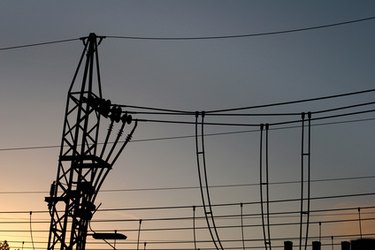
Learning how to strip electrical wires at their middle to make electrical connections takes a little practice to master. It can be a little tricky, especially if you are not used to handling an electrician's knife to remove insulation, but it is a skill that everyone who works with electricity has to learn. You will use this method of making splices repeatedly if you undertake any outdoor festoon lighting projects. You will also need to use this method to tap into an overhead feeder.
Step 1
Hold the electrician's knife at an angle of roughly 30 degrees to the wire, at the point where you want to start removing insulation. Holding the knife at a shallow angle is critical because you want to cut through the insulation without having the sharp edge of the blade bite into the wire itself. Cutting into the copper or aluminum conductor will weaken the conductor, causing it to break under stress.
Video of the Day
Step 2
Remove the insulation for a distance of 1 and ½ inches along the wire. If you are working with wire that has a thick insulation, like rubber and cloth-insulated wire, taper the ends of the insulation down to the bare conductor. Do not hold the knife blade perpendicular to the wire to make a flush cut. It is almost impossible to make a flush cut without "ringing" the conductor. "Ringing" is where a groove is cut all the way around the copper or aluminum conductor. "Ringing" not only weakens the conductor; it also reduces the conductor's cross-section area, which increases its electrical resistance. Weakening the conductor and increasing its resistance are to be avoided at all cost.
Step 3
Clean the stripped wire (conductor) of any residual insulation. Residual insulation is usually not a concern when stripping modern thermoplastic insulated wire but will become a concern when working with cloth and rubber insulated wiring. Using the electrician's knife as if it were a straight razor, carefully scrape the large particles from the wire. Once you have removed the largest particles use steel wool to remove the smaller particles.
Tip
Make you splice as quickly as possible once you have stripped the wire. All wire starts to oxidize as soon as it is exposed to air, but aluminum wire oxidizes exceedingly quickly and oxidation makes for a high-resistance electrical connection. A high-resistance connection causes a voltage drop to occur across it preventing all the voltage from reaching the load. Voltage drops can damage your equipment, but even more worrisome is that these connections heat up, thus setting the stage for a fire.
Video of the Day